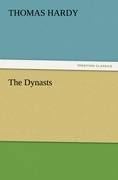Originally published 1903 | ||
 | ||
People also search for Prometheus Unbound, Samson Agonistes, Man and Superman | ||
The Dynasts is an English-language drama in verse by Thomas Hardy. Hardy himself described this work as "an epic-drama of the war with Napoleon, in three parts, nineteen acts and one hundred and thirty scenes". Not counting the Forescene and the Afterscene, the exact total number of scenes is 131. The three parts were published in 1904, 1906 and 1908.
Contents
Because of the ambition and scale of the work, Hardy acknowledged that The Dynasts was not a work that could be conventionally staged in the theatre, and described the work as "the longest English drama in existence". Scholars have noted that Hardy remembered war stories of the veterans of the Napoleonic wars in his youth, and used them as partial inspiration for writing The Dynasts many years later in his own old age. In addition, Hardy was a distant relative of Captain Thomas Hardy, who had served with Admiral Horatio Nelson at Trafalgar. Hardy consulted a number of histories and also visited Waterloo, Belgium, as part of his research.
George Orwell wrote that Hardy had "set free his genius" by writing this drama and thought its main appeal was "in the grandiose and rather evil vision of armies marching and counter-marching through the mists, and men dying by hundreds of thousands in the Russian snows, and all for absolutely nothing."
Synopsis
In addition to the various historical figures, The Dynasts also contains an extensive tragic chorus of metaphysical figures ("Spirits" and "Ancient Spirits") who observe and discuss the events.
Part First contains a Forescene and six Acts with 35 Scenes. The time period of the events in Part First covers 10-months, from March 1805, the time when Napoleon repeated his coronation ceremony at Milan and took up the crown of Lombardy, through January 1806, the time of the death of William Pitt the Younger. The principal historical events entail Napoleon's invasion plans for England, which are abandoned when French Admiral Pierre-Charles Villeneuve sails for the south, the Battle of Trafalgar, and subsequently the Battle of Ulm and the Battle of Austerlitz. The division of the Acts and its Scenes is as follows:
Part Second contains six Acts with 43 Scenes. The time period of the events of Part Second ranges over 7 years, from 1806 to just before the French invasion of Russia in 1812. The listing of the Acts and Scenes is as follows:
Part Third contains seven Acts with 53 Scenes, and an After Scene. The historical time period of Part Third covers Napoleon's invasion of Russia in 1812 through his defeat at the Battle of Waterloo in 1815. The division of the Acts and Scenes is as follows:
Analysis
Hardy regarded The Dynasts as his magnum opus and devoted much of his later life to its completion, but the work was not well received, and later critics have seen little reason to reverse that judgement. There is a case to be made, however, for the drama's having pioneered techniques that would later be regarded as characterising literary Modernism. Moreover, The Dynasts remains of interest to those studying Hardy's novels, both for the insight into his world-view and for its examination of a character mentioned famously but briefly at the end of Tess of the d'Urbervilles: the "President of the Immortals".
The design of The Dynasts is extremely ambitious, and because of its coverage of historical events of the same era, has received comparison to Tolstoy's War and Peace. Emma Clifford has written that Hardy used Tolstoy's novel as one of many sources of inspiration for the work, and in fact owned an early translation. However, it was not necessarily as a primary source, as Hardy also drew on the History of Europe by Archibald Alison, among others.
Hardy juxtaposes scenes of ordinary life with scenes involving the principal historical figures of the age, and concentrating on their desire to found dynasties to preserve their power. There are extensive descriptions of landscape and battle scenes that are characterised by shifts of visual perspective that, in the opinion of John Wain, anticipate cinematic techniques. George Witter Sherman has postulated on Hardy's observations of life in London as influences on elements of The Dynasts. Elna Sherman has discussed Hardy's references to music and songs in the work. Anna Henchman has written about Hardy's use of imagery in the manner of astronomical observation at great distances from the earth in this work. Lawrence Jones has analysed Hardy's idiosyncrasies in his manner of narrative in The Dynasts. J.O. Bailey has postulated an analogy of the Spirits in The Dynasts with other Mephistopheles-like figures in literature, and in relation to the Book of Job.
